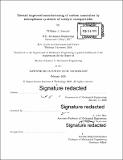Toward improved manufacturing of carbon nanotubes by microplasma synthesis of catalyst nanoparticles
Author(s)
Sawyer, William J.(William James)
Download1200095112-MIT.pdf (14.80Mb)
Other Contributors
Massachusetts Institute of Technology. Department of Mechanical Engineering.
Advisor
A. John Hart.
Terms of use
Metadata
Show full item recordAbstract
Individual carbon nanotubes (CNTs) can have exceptional mechanical, thermal, and electrical properties. However, the scale-up of these remarkable properties to macroscopic applications requires high-throughput synthesis of CNTs with low defect concentration and atomic-level order that is maintained throughout an assembly. This has been largely unsuccessful outside of laboratory settings. Aerosol chemical vapor deposition (CVD) synthesis, the standard method of producing CNTs at scale, involves the coupled generation of a -10 nm diameter high concentration catalyst aerosol with subsequent CNT nucleation and growth within a single high temperature reactor. Direct coupling of particle generation with the CVD process limits the generation of smaller, 1-5 nm diameter particles needed to improved CNT quality and reduce catalyst impurity levels, typically 10-30 wt%, in the final CNT product. Additionally, the dissonance between predicted and actual production rates, cost, and product quality suggests issues of process reliability and control. The goal of this thesis is to identify and demonstrate principles for improved CNT manufacturing and quality control using a custom aerosol CVD reactor with online analytics. Central to this system is a novel microplasma technique for decoupled catalyst generation, which allows for control and monitoring of the catalyst particles independent of the CNTs. This microplasma process provides tunable and stable generation of iron nanoparticle aerosols down to 1.3 nm diameter, an improvement over the 3 nm minimum of other decoupled techniques, with a 100-fold increase in concentration. Methods for independent control of diameter and concentration have been identified, and an aerosol concentration of 10⁹ #/cm³, comparable to thermal catalyst generation, can be generated down to 2.5 nm diameter. The microplasma generator is assembled with a custom CVD reactor, enabling the generated catalyst to be provided directly to the furnace. The capability of the system has been validated with baseline CNT synthesis under proven CVD conditions, characterized via SEM and Raman spectroscopy. Together, these findings suggest that microplasma catalyst generation is a critical building block of a new high quality CNT synthesis process, and motivate continued research and development of this system.
Description
Thesis: S.M., Massachusetts Institute of Technology, Department of Mechanical Engineering, 2020 Cataloged from PDF of thesis. Includes bibliographical references (pages 117-132).
Date issued
2020Department
Massachusetts Institute of Technology. Department of Mechanical EngineeringPublisher
Massachusetts Institute of Technology
Keywords
Mechanical Engineering.